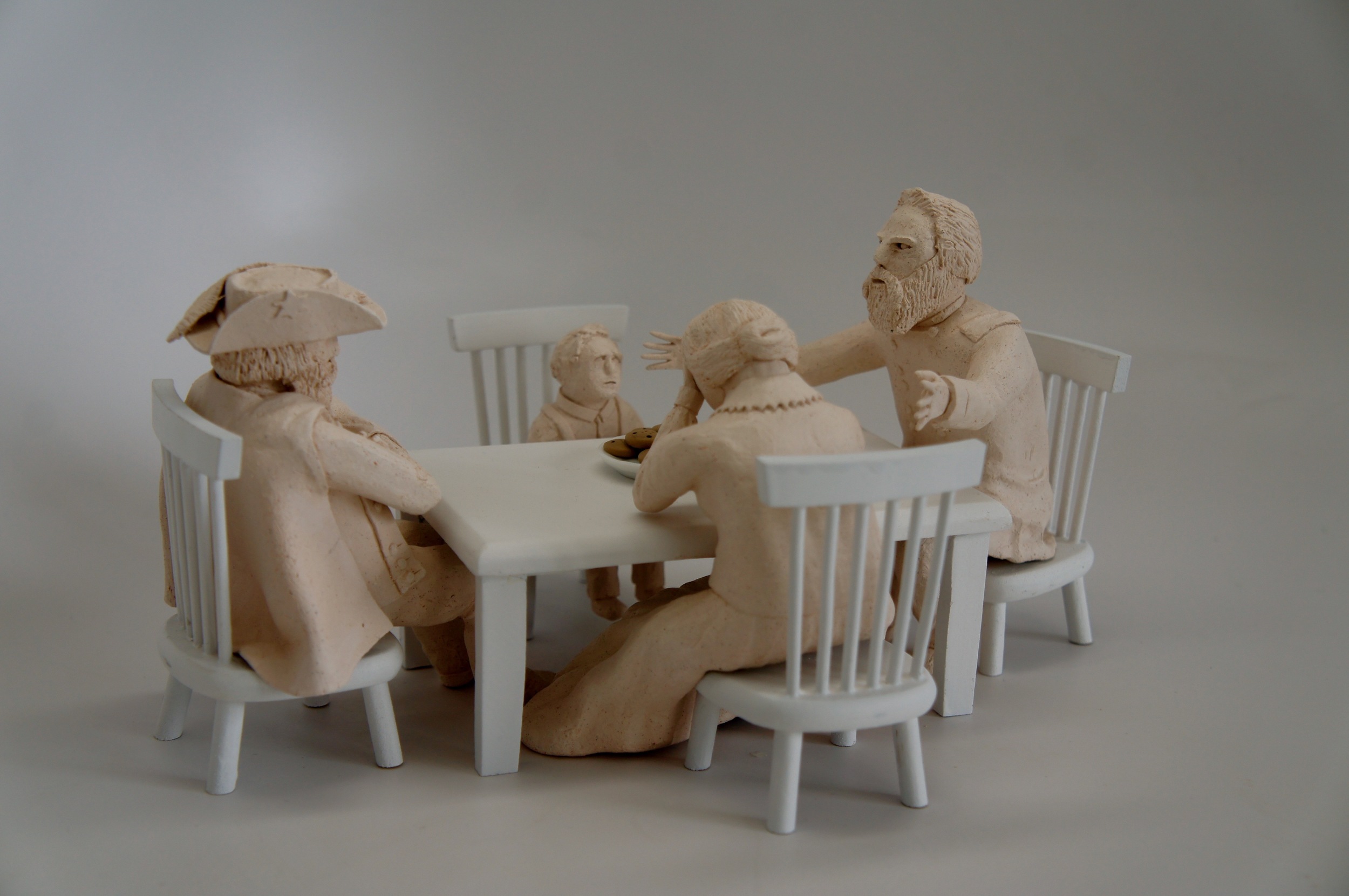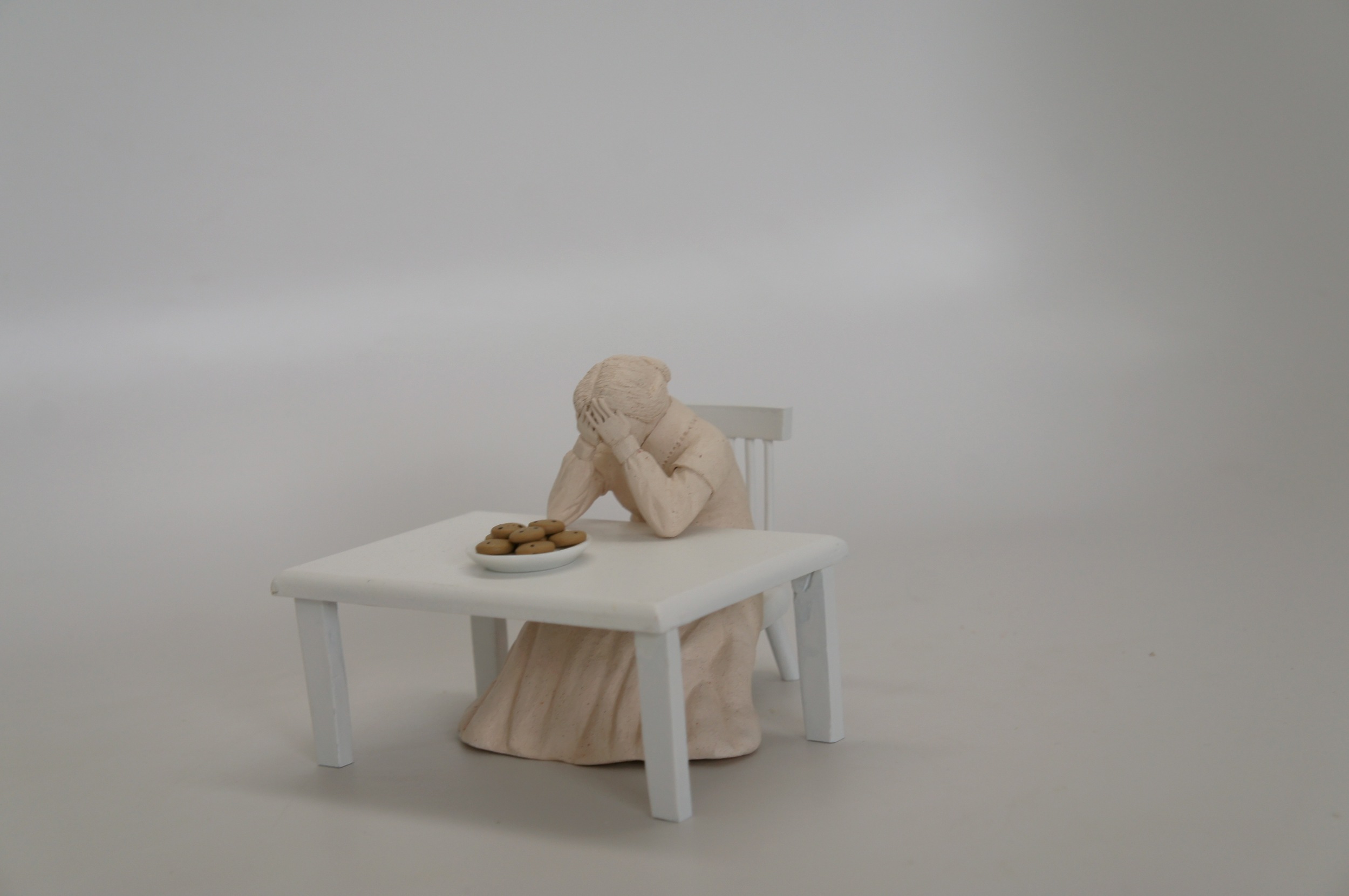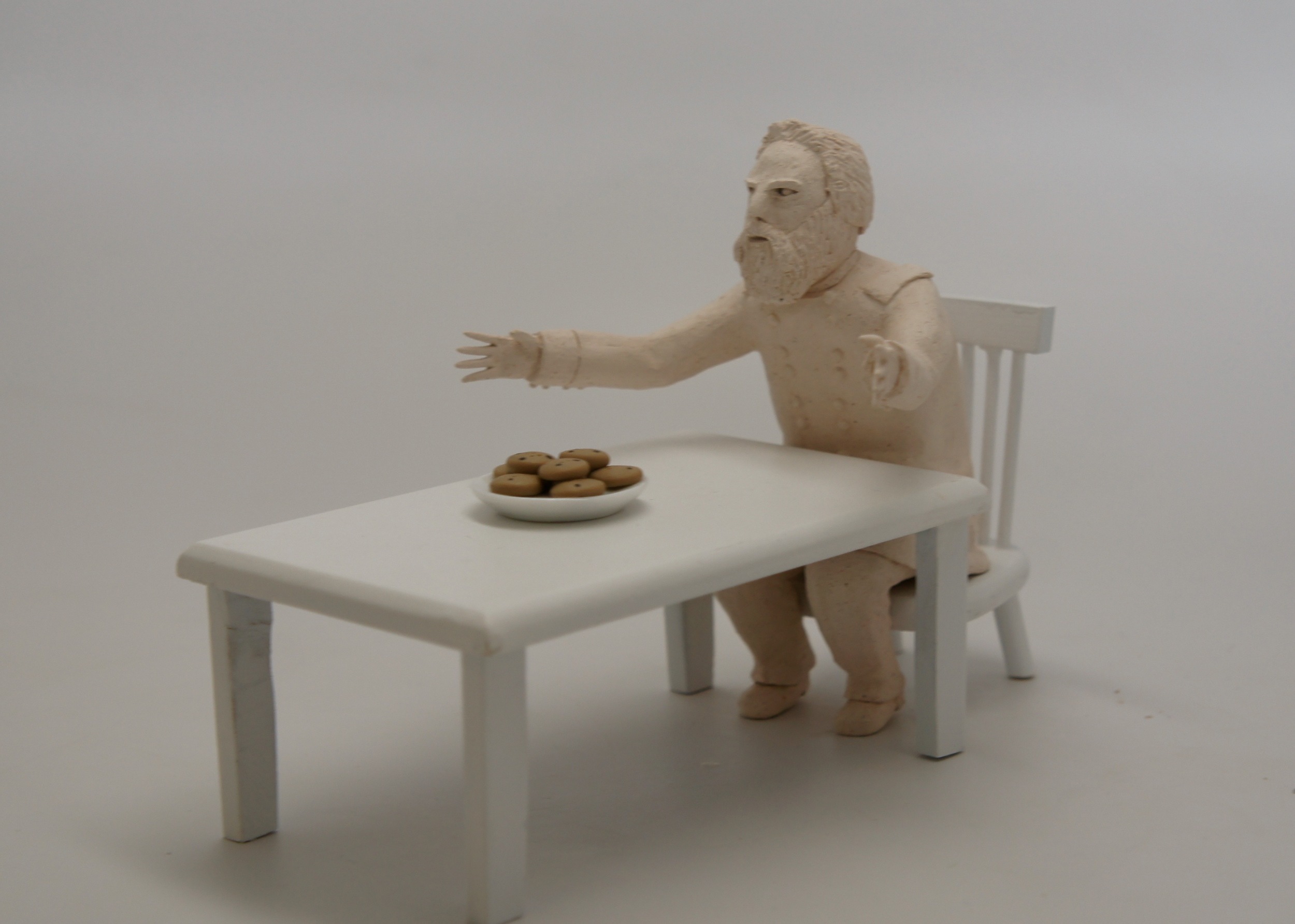These are all stories from the American Civil War, although since the war 150 years have passed as one historian puts it, "It's important that we tell the story of what has happened in this country because that's what shaped and molded us as a nation."







Cuckold
2016
Ceramic, wood, mixed media
7.5 x 14 x 9.5 inches
Earl Van Dorn, Civil war general with insatiable appetite for glory and an incurable penchant for the ladies. Once referred to in a newspaper as “The terror of ugly husbands”, “His bearing attracted, his address delighted, his accomplishments made women worship him.” After two successful cavalry raids, unwilling to rest of his laurels now that fortunes smile was broadening still further he returned to his room at Spring Hill to to work on plans for further harassment of the enemy and to see his current paramour Jessie McKissack Peters, wife of a local doctor. But it soon become apparent fortunes broad smile had turned out fickle after all when he was interrupted by the doctor himself who promptly shot him in the back of the head. And this is the story of the end of one certain reign of terror.







Uncivil Wars
2015
Ceramics, wood, plastic.
4 x 9 x 7 x inches
When General Jeb Stuart’s father in law refused to join him in fighting for the Confederacy, and instead became a Brigadier General with the Union army, Stuart’s response was cold fury, writing of his father in law’s decision “He will regret it but once, and that will be continuously.” The feud tore the family apart: Stuart was determined to change the name of his son, as he would not have his sons name honor a man he considered dishonorable. Stuart who would be mortally wounded at the Battle of the Yellow Tavern, leaving his widowed wife to wear black for the rest of her life in remembrance. His father in law lived long enough to write several memoirs of his 50 year army service, none of them regretful.


Judah Benjamin Cannot Escape His Tribe
2016
Ceramics, wood, paper
4 x 6 x 3 inches
Judah P Benjamin, known as the “Brains of the Confederacy, was the first and only Jew to be featured on American currency, albeit the currency of the Confederacy. Not an observant Jew, Benjamin considered himself an intellectual, a Jew of the Head and not the Heart. He avoided his Jewishness, yet his political enemies never let him forget it calling him “Davis’s pet Jew,” and “cheap, very cheap.” In this scene, Benjamin looks up to see his Rabbi approach, Torah in hand, inviting him for Passover.
On the Way to Atlanta, Sherman's Psychiatrist Suggests Lithium
2016
Ceramics, Mixed Media
4 x 7.5 x 9 inches
William Techumsah Sherman, Originator of total war, and our only true celebrity general . Known with Grant as the men who won the civil war, his men scorched much of Georgia in his famous March to the Sea He and would gain perpetual infamy in the South as the grim reaper of the Union war effort. Yet, as few Americans know, during the first year of the war, General Sherman, paralyzed by depression, would be relieved of his command in Kentucky at his own request. The wire services proclaimed to the nation: GENERAL WILLIAM T. SHERMAN INSANE. Throughout the first six months of the war, Sherman’s psyche was dominated by self-doubt and fear. He was a tortured man suffering what has long been defined in psychiatric terms as intense mania. Shermantalked incessantly while never listening, all the while repeatedly making “quick, sharp…odd gestures,” pacing the floor, chain-smoking cigars, “twitching his red whiskers — his coat buttons — playing a tattoo on the table” with his fingers. All in all he was “a bundle of nerves all strung to their highest tension.” Back at his hotel, other guests observed him pacing all night in the corridors, smoking and brooding, “and it was soon whispered about that he was suffering from mental depression.” Such increased energy, talkativeness and hyperactivity (which can sometimes become impulsive and even psychotic), is the definition of mania, the twin — and opposite — of depression in the illness of bipolar disorder. In a new fit of mania on his march to the sea Crazy Billy, stops off at his therapist, for the newest in psychopharamalogical help.
The next two pieces are stories about legacy, and the symbols we create . These are prickly subjects, and while making the work I found myself uncomfortable. But while finding myself uncomfortable, and questioning the work I knew I had to make it. With this work my goal is not to posit a position on whos monument should be removed or not. But to open up a line of questioning on the subject. The didactic tropes of history, Hes good, hes evil. History is sloppy and things are never as clear cut as we would like.


The Seamstress
2016
Ceramic, wood, mixed media
8.5 x 15 x 10 inches
In December of 2015, a bill was planned for the removal of Confederate monuments in New Orleans. It planned the removal of the monuments of three men, Jefferson Davis Confederate President, Robert E Lee, and PGT Beauregard. I had known the stories of the more famous Lee and Davis but I was curious on this man Pierre Gustave Toussaint Beauregard. I then read Beauregard’s biography Napoleon in Gray. And I wondered who is this man to get such an appellation. And what is ones life after his monument is removed? In reading his biography, I found the story of a man whos life’s was to gain recognition, a man who spoke better French than English and as a creole who never felt truly at home in America. A man who go would go from be called “the first paladin of the confederacy” who to after the war spending his days in the ignoble post of Louisiana Lottery commissioner drawing the lottery wheel wondering how differently it could have gone.
Also tied to the story of PGT Beauregard was the story of the Confederate flag. Beauregard had concern for his troops, before the first battle of the war realizing the difficulties of differentiating the federal and union troops in battle. The war having just started, everyone was mostly in pre war state militia uniforms, there if anything it was more Yankee grey and Confederate blue. He suggested his men wear red and orange colored scarves extending shoulder to waste. The idea was shelved as sound but extravagant as well as impractical. With the actual Confederate state flag, the “stars and bars” looking to similar to the American flag the “stars and stripes”, Beauregard suggested that Congress be asked to adopt a new flag. This, plan too, was declined. And so the first battle of Bull Run would come and go. And as expected course there were great amounts of friendly fire incidents. Beauregard then decided to design a special flag to be carried into battle. And so was born the famed Southern battle flag, which would later be often mistaken for the flag of the Confederate States. The three official flags of the Confederate States have been since largely forgotten. The flag came into birth as a utilitarian, pragmatic object to prevent further unintentional “effusion of blood” as would be said. I’m not looking just at the Civil War, but at the way we construct symbols. Initially the flag was just a way of distinguishing one group of soldiers from another, but now it has come to represent race hatred, slavery, and oppression. Even in the controversy over the Confederate flag, it was almost as if the flag had caused these injustices, rather than the people.
I then began to think the piece was not as much about Beauregard as it was about the women who sewed the first Confederate flags. The Cary sisters, or known as the “Cary Invincibles”. Three of the most beautiful belles in the south. Sort of the Kim Kardashian sisters of 1860s Richmond. Hetty Cary the seamstress of the first flag, at one point in Baltimore standing from an upper window of her home, waved the Confederate flag flagrantly showing off to the Union troops who marched by. An officer observed the rebellious woman, and inquired to his commanding officer if he should have her arrested. In reply, the commander shook his head with a negative response and replied. "She is beautiful enough to do as she damn well pleases!" But Carys life was also not without misfortune, from Marrying General John Pegram at St. Pauls church in one of the largest events of Richmond, to three weeks later to the day, exchanging her wedding veil for that of a widower at his funeral in the same church, with same minister officiating and all the same guests in attendance. "she was like a flower broken in the stalk."
The story of the flag then brought me to the story of Dylann Roof, who in June of 2015 committed the horrible mass shooting at African American Charleston prayer group killing 9. In the aftermath of the the shooting, many images on the internet of him holding up the confederate flag would be found. And so began the fervor over its flag and removal, and in turn the removal of anything relating to the command of the Confederacy from changing the name of Albert Sidney Johnston highschool to the renaming Fort Bragg.
What would Beauregard think? In 1873 a party committee that Beauregard chaired put forth a detailed written plan for conciliating the races. They would meet beneath a banner that read "Equal Rights—One Flag—One Country—One People." Lest there be any doubt about which flag this referred to, Beauregard's plan resolved, as one of its concluding pronouncements, to cultivate "a broad sentiment of nationality, which shall embrace the whole country, and uphold the flag of the Union."
This is the story of PGT Beauregard, the flag, and him looking at Roof wondering where his ideas where obfuscated. And in story of an not a first-rate military man but a first-rate second-class man. An American who now has to worry about being forgotten again. "This is not a fullstop marking the end of a story but a question mark inviting response and reflection"



Sheridan Meets a Bad Indian
2016
Ceramics, Bronze, stone
4.5 x 6 x 4.5 inches
This is the story of General Philip Sheridan. Anytime we pass a street named Sheridan or the more famous Sheridan Square in New York City or Sheridan circle in DC, not to mention the 5 counties, 7 cities and tank named after him we rarely think of the man all these are named after. “lil phil” as he was called, standing only 5 feet 5 inches at most, 2 less than napoleon. Trademark flat-brimmed porkpie hat always clamped on his distinctive bullet shaped head. A contemporary would say of him “a brown chunky little chap with a long body, short legs, and not enough neck to hang him,” Sheridan was One of the hardest hitting union commanders of the civil war, not afraid to lead at the head of a charge, once when told he exposed himself more than a core commander should he replied, “I have never in my life taken a command into battle, and had the slightest desire to come out alive unless I won.” A soldier would say of him in battle “hat in one hand and sword in the other, fighting as if he were the devil incarnate.” But there was another side to Sheridan.
Sheridan would continue to gain fame for his post war career as indian fighter and his merciless suppression of the plains Indians. All the while endorsing the slaughter of the buffalo along the way, speaking of the buffalo hunters to the Texas legislator against a bill protecting the buffalo, “Send them powder and lead if you will, and for the sake of peace let them kill, skin, and sell until they have exterminated the buffalo” He proposed sending 10 regiments to assist in the slaughter of buffalo until almost none were left and instead of stopping the hunters from killing buffalo, instead giving them bronze medals with a dead buffalo on one side and a discouraged Indian on the other. Sheridan is probably best known now 150 years later for his now famous quotation which came about when a Plains Indian chief introduced himself as a good indian. Sheridan responded “the only good indian is a dead indian.” The actual reported quote was “The only good indians I ever saw were dead” I began to think on that quote, then what is a bad Indian? I thought of Chief Wahoo, mascot of the Cleveland Indians. Although Wahoo has been demoted to secondary logo Owner Paul dolan notes that the chief isn’t permanently going away, though. “It is part of our history and legacy” But Wahoo might not be going away at all on the recent opening day the team was seen proudly wearing Wahoo emblazoned caps and jerseys. Sheridan looks on at while the chief throws his pitch, and ponders on his own history and legacy and if his monument is next to go.

